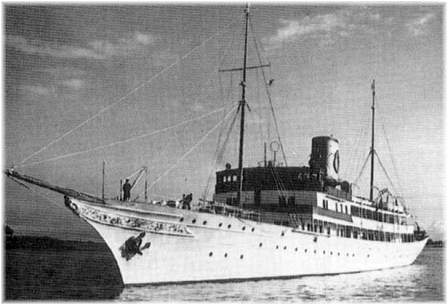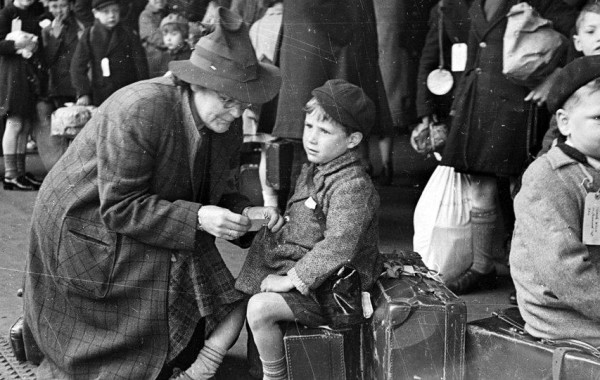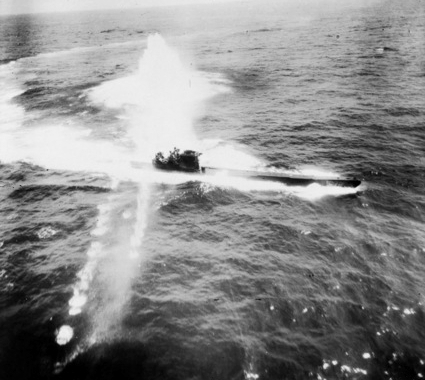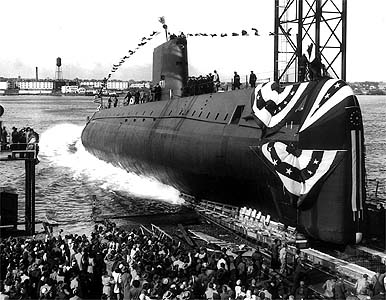When Captain Joseph Gainard pointed City of Flint’s bow toward Halifax, Nova Scotia, on Sept. 4, 1939, his 20-year-old freighter had never carried so many passengers – 265 people, all but 29 being survivors of the torpedoed British passenger ship Athenia. (See blog post City of Flint Odyssey, Part 2, Oct. 1, 2015.)
Gainard and his crew faced a voyage of nine days and the captain immediately set about organizing his ship for the long haul. To oversee passenger matters, he set up a small “cabinet” that included two of Flint’s original paying passengers, her chief officer, and her steward.
“We had to figure things to do to keep all that crowd occupied,” Gainard later wrote. “We didn’t have any space for them to play games so we doubled up on some of the jobs, two sweepers to a broom; anything to keep them busy to take their minds off their troubles.” To the captain’s great satisfaction, nearly everyone aboard volunteered to take up some duty.
With help from several passengers, City of Flint’s carpenter completed building 250 bunk beds on the Shelter deck by the next evening, Sept. 5. To help find their way through the maze of beds, passengers put up names to identify various locations. Polish and Czech survivors occupied the “Polish Corridor” and “Sudetenland;” Canadians gathered in “Montreal” and “Quebec;” while names like “Madison Avenue,” “Times Square” and “Seventh Avenue” identified American sections.
Dining was a particular challenge. Before sailing, City of Flint’s steward had arranged enough food to feed 60 people for 90 days, never imagining how fortuitous his planning would prove. But the sheer number of passengers to be fed three times a day threatened to overwhelm the ship’s two small dining facilities. The cabinet set up a system of seatings, similar to the dining arrangements on a passenger ship. Diners picked up their plates and utensils, had a time limit to finish their meals once they were served, and carried their dirty dishes to the washroom. Other passengers, working in shifts, cleaned the plates and utensils for the next set of diners.
Passing ships helped to augment short supplies on City of Flint, sending across blankets, milk, fresh vegetables, medical supplies, and toys and candy for the children.
The cabinet established an entertainment committee, which organized passenger talent shows featuring singers, magicians, and story tellers. A dance instructor from a women’s junior college did the hula to the rhythm of a drum made by stretching canvas over an empty trash can. Passengers also held a limerick contest and conducted a fashion show featuring various “models” wearing their most outlandish makeshift outfits.
One of the passengers, a baker from Albany, NY, fashioned a cake for a party for the children on board, complete with presents of toys and candy supplied by a generous passenger on one of the passing ships. The children also put on a talent show to rival the adults.
Sadly, early on the morning of Sept. 9, the 10-year-old girl, Margaret Hayworth, who had received a head wound in the torpedo attack on Athenia, succumbed to her injury. Not wishing to add to the grief of the survivors who already had been through so much, Gainard decided not to announce the child’s death to the general population of passengers.
On the morning of Sept. 10, two U.S. Coast Guard cutters met City of Flint and took up positions on either side of the cargo ship to escort her the rest of the way to Halifax. The cutters took on board 10 injured survivors so they might enjoy less crowded conditions and have more medical personnel to look after them.
Three days later, City of Flint entered Halifax Harbor to little fanfare. “There were no welcome boats dashing about the harbor, no launches or hollering or shrieking tugs—no whistles,” Gainard said. “This was in line with my request the night before, and was, in fact, appreciated by the Canadians who did not feel that the sinking of the Athenia was any occasion for a celebration.”
As his passengers disembarked, Gainard might well have thought that he could slip back into the welcome anonymity of a merchant mariner. Fate, however, had different plans for the colorful captain and his ship. More about that in our next blog.











